The Michigan Thumb looks green and fertile today, but in the 1800s it hid a tinderbox. Decades of logging left heaps of “slashings” – treetops, branches and sawdust – on the ground. Farmers routinely burned these clearings each fall. By September 1881, an exceptional drought and hurricane-force southwest winds had turned the landscape into an inferno ready to ignite, leading to the catastrophic 1881 Parisville Fire.
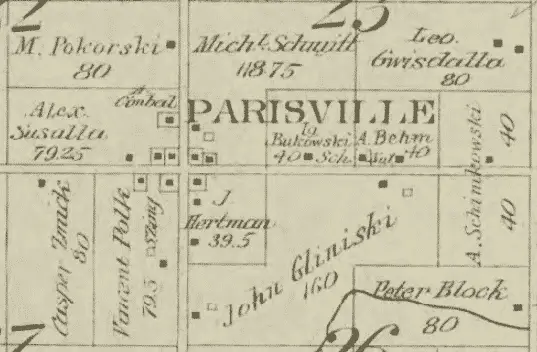
Just days into the dry spell, dozens of small blazes flared up across Sanilac, Tuscola and Huron counties. On September 5 a perfect storm hit: high winds swept these fires together and drove them eastward. At Parisville – a farm village in Paris Township, Huron County – the 1881 Parisville Fire arrived suddenly in the early afternoon. A witness would later recall a “solid wall of flame fifty or a hundred feet high” rushing down the ridges. So intense was the heat that daylight went dark at noon.
The Fire’s Main Target – The 1881 Parisville Fire
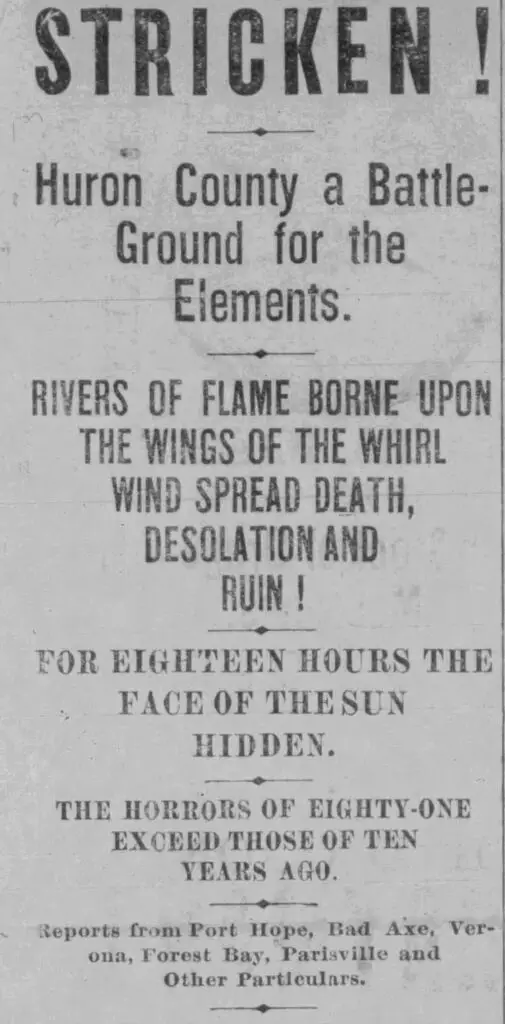
The Great Michigan Fire of 1881 devastated one town above all others; Parisville. Parisville’s roots lay far from Michigan. The town had been settled in the 1850s by Catholic families from Poland. These pioneers (escaping Prussian oppression) worked their way through Ontario before reaching Michigan’s rich Thumb region.
In 1854 the first Polish settlers bought virgin farmland for 50¢ an acre, built a small chapel (St. Mary’s) by 1858, and by 1880 had a church, school, a hotel and clustered farms?. They cleared the woods with axes and saws, and by 1881 their village was a one-corner farming community surrounded by groves of hardwood and swampland. The summers were usually humid, but the summer of 1881 had been mercilessly hot and dry, and in the morning of September 5 the stage was set for disaster.
1881 Fire That Destroyed Michigan’s Thumb
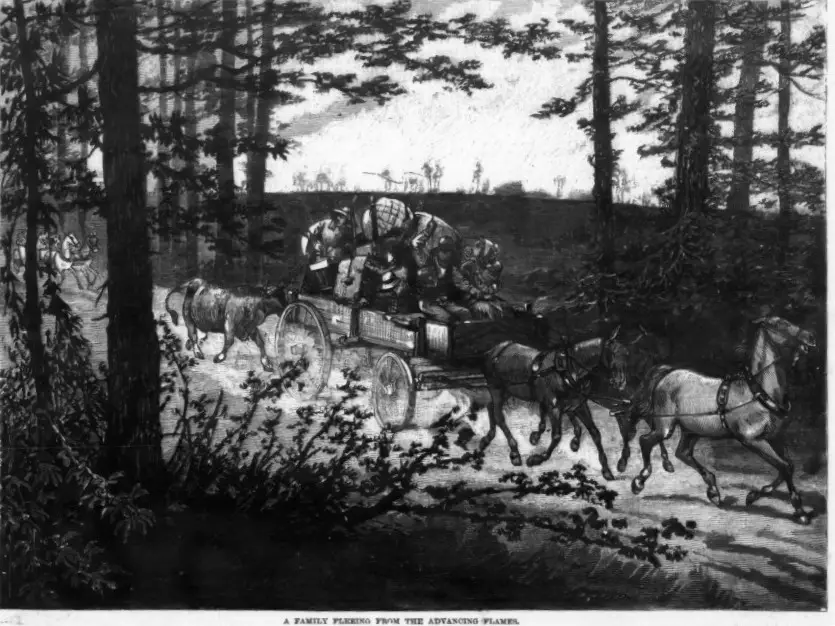
On September 5, 1881 (Labor Day Monday), the conflagration bore down on Parisville with almost supernatural speed. By about 2:30 pm the main firestorm swept over the township from the west. In minutes the farm fields and woods burst into flame. Parisville suffered the worst blow of the entire fire. Official U.S. Army records later reported that Paris Township lost 446 buildings and 22 people in the 1881 fire – far more than any other community in Huron, Tuscola or Sanilac counties. Contemporary newspapers even claimed over 500 dead and 1,500 homeless from the regional fire. Eyewitnesses described entire families fleeing their burning homes and burying victims side-by-side in hastily dug trenches due to a shortage of wood for coffins.
The Paris township community was also in the path of one of the largest forest fires of the 1880’s. The Great 1881 Fire Parisville left a scorched a mass of land 60 miles long north to south and 30 miles wide across the eastern half of Huron and Tuscola counties and most of Sanilac County.
According to records filed by the US Army after the Great Fire of 1881, Parisville township was listed as having the 446 buildings destroyed and 22 lives lost. This was the greatest amount of devastation within the three Michigan counties that experienced the great fire. (1)
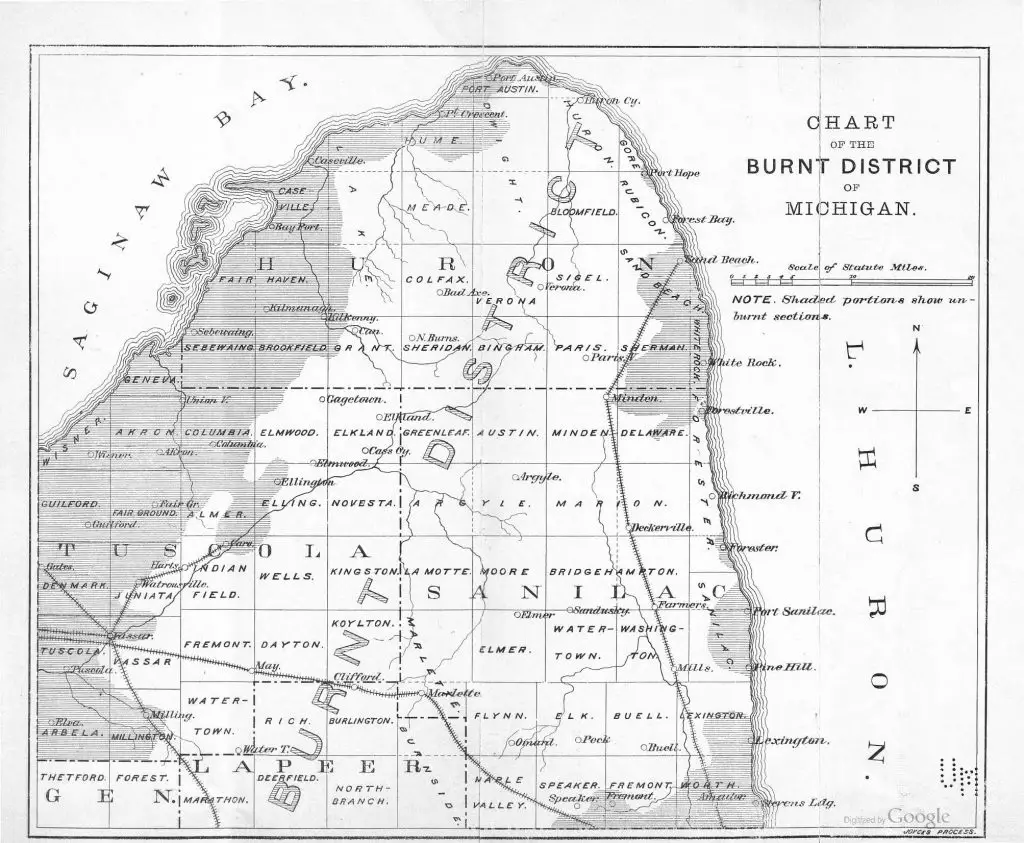
Eyewitness Accounts of the 1881 Fire in Parisville
When Parisville was finally overrun, it was engulfed in a wall of flame. One of the most amazing stories was revealing in a letter from Deine Schwester to her family in Europe. Here is an excerpt.
“Tuesday morning the nuns were here collecting for the poor. The sky looked shadowy and opaque. Our chickens had vanished. The horses were skittish. Then we smelled smoke. August, it happened so fast! The forest to our west was burning! Wind carried sparks through the treetops, setting everything around us ablaze.
Flames surrounded our hotel. There was no escape. We fixed an icon of Our Lady to the front porch and raced back inside. We prayed. Four hours the fire roared! Timbers creaked. Windows cracked. Heat blasted. An unsettling silence followed. We opened the door and crept out past Our Lady. There was not a blister or burn on her. Yet the fire had consumed everything. Charred bodies of man and beast littered the landscape. The air reeked of soot and singed hide.” (1)
The detail of that letter brings home how fast the fire moved and how helpless people felt.
Remarkably, the destruction in Parisville was uneven. U.S. Army engineer William O. Bailey’s report noted that near St. Mary’s church one small cluster of farms survived intact while all around them burned. For example, on one property all the outbuildings and fences were incinerated, yet a stack of hay and its fencing – just a few feet away – remained untouched?. In other spots a single house stood alone amid charred fields of corn. These odd survivals fed local stories of divine protection and miracles, as the community tried to make sense of the horror.
The Four Miracles at Parisville

Some of the most vivid images of that day come from survivors’ accounts. One convent nun’s letter (translated) graphically describes the fire’s sudden arrival (excerpt above). The town’s historian and long-time resident Michael Ulfig (who helped run the Paris Township museum) collected oral traditions of four “miracles” from 1881. These tales became part of Parisville’s identity. In broad terms, they are:
The Virgin Mary icon. Before the fire, a family (the Klebbas) had placed a wooden painting of the Blessed Virgin Mary on their porch. Though their house was later destroyed, the icon and porch emerged unburned?. According to Ulfig, both the small shrine and cottage “were fixed to the front porch,” yet after the fire “both the home and artwork survived” miraculously?.
A wandering cow. Shortly after the blaze, a lone cow wandered into Parisville from the woods. The hungry, burned-out settlers welcomed the animal as a blessing. It gave fresh milk at a time when people had almost nothing left to eat. “You see, the people had nothing to eat or drink, and now they had milk at least,” Ulfig recalled?.
The unburned hay. Two wagonloads of fodder – donated by farmers for the local priest – survived the flames perfectly. Hay is highly flammable, and its preservation struck people as a sign. Ulfig noted wryly that it “show[s] donations are from above,” given that “hay is so dry it should just go up like that” in a fire.
The church cross. Outside St. Mary’s Catholic Church stood a wooden cross on a tall pole. Everything else around the church burned, but the cross remained standing. Parishioners took its survival as a final miracle marking the site as holy and protected.
These stories (whether one interprets them as divine intervention or coincidence) gave villagers hope. They told and retold them as they rebuilt. In fact, by 1890 Paris Township was flourishing again. A contemporary county atlas from 1888-1890 notes that Parisville had recovered from the fire and ranked “one of the most productive townships in the Thumb.” State historians credit this to the soil: the fire, while destructive, also turned the soil nutrient-rich. As Michigan historian Roger Rosentreter observed, “That fire left a lot of fertile soil behind,” and afterward the Thumb “became one of the richest contributors to Michigan agriculture for more than a century.”
Aftermath, Remembrance, and New Research
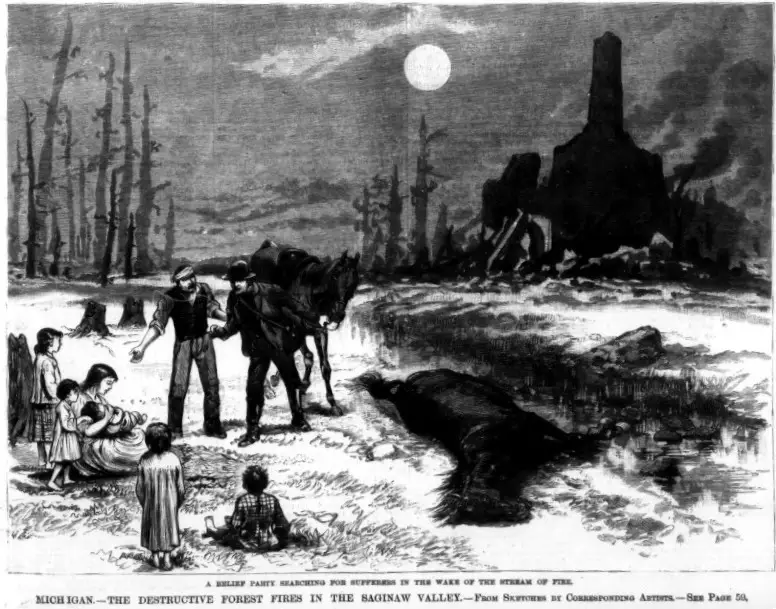
Within a few years of the disaster the shattered town was largely rebuilt. New homes replaced charred ruins and fields were resown. St. Mary’s Church itself was eventually reconstructed on the site, continuing Parisville’s heritage. By the turn of the century local business directories again list grocers, a post office and a barber in Parisville – a sign of normal life returning.
Over time the fire became local legend. Paris Township’s small historical society (and museum) preserves 19th-century photographs, newspaper clippings and diaries of 1881. In 2004, residents celebrated the community’s 150th anniversary by sharing stories of the blaze. Recent historians and genealogists continue to investigate Parisville’s past. For example, Charles Chase published Parisville/Paris Township: The Oldest Polish Settlement in Michigan in 2019, a book detailing the village’s founding families.

In 2021 formal commemoration came to Parisville. On June 5 the Polish Genealogical Society of Michigan placed a historical marker at the corner of Parisville and Atwater Roads. The ceremony honored the 1850s pioneers and explicitly mentioned the fire: one speaker noted that these settlers “had to suffer through devastating county-wide fires in 1871 and 1881” as they forged their community. The new plaque proudly proclaims Paris Township as the state’s oldest Polish settlement,ensuring that visitors learn not only about the immigrants’ faith and farming, but also their endurance through tragedy.
Today, 140 years after the flames died out, historians agree that the Great 1881 Michigan fire forever changed Parisville’s story. But thanks to contemporary accounts, official reports and community memory, the facts are not forgotten. The scar of the 1881 fire is still visible – some of Paris Township’s original forests never fully returned – but so is the legacy of those who rebuilt on the ashes. As one recent author concluded, the dramatic tale of the 1881 fire “became woven into the fabric of Parisville,” a reminder of both peril and perseverance in Michigan’s history.
FAQs About the Great Fire of 1881 that Distroyed Parisville
What caused the 1881 Thumb Fire in Michigan?
The 1881 Thumb Fire was sparked by a deadly combination of drought, high winds, and leftover debris from extensive logging. Farmers routinely burned brush piles, and on September 5, 1881, small fires merged into a massive inferno driven by gale-force winds, consuming over a million acres.
How badly was Parisville affected by the 1881 Thumb Fire?
Parisville was the hardest-hit community, losing 446 buildings and 22 lives—the worst toll in the region. The firestorm leveled nearly the entire village, leaving little behind but ash and a few miraculous survivals, including a wooden crucifix and scattered haystacks.
Were there any reported miracles during the 1881 Parisville Fire?
Yes, local lore tells of four miracles: a Virgin Mary icon that survived untouched, a lone cow that wandered in and provided milk, two unburned hay wagons, and a church crucifix that remained standing amid total destruction. These stories became part of Parisville’s identity.
How did Parisville rebuild after the 1881 fire?
Despite the devastation, the residents of Parisville quickly began to rebuild. With aid from nearby towns and fertile soil enriched by the fire’s ash, the community recovered within a decade. By the 1890s, Parisville was once again a thriving agricultural hub.
Related Links to 1881 Great Michigan Fire
- The fires of September 4th through the 6th 1881, commonly known as the Thumb Fire, took hundreds of lives and burned well over one million acres. The fire destroyed major parts of Tuscola, Huron, Sanilac, and St. Clair counties. It forever altered the landscape of the Upper Thumb and its effect is seen in the area today. The 1881 Fire Forever Changed the Thumb
- It was Sunday, October 8 that fires near Peshtigo Wisconsin and Chicago came to life. No one is certain how they started. Popular lore of the Chicago fire tells that a cow, owned by Mrs. O’Leary, purportedly knocked over a lantern in her barn that set off the blaze. While in Wisconsin, a sudden fire mysteriously starts outside of Peshtigo. A few hours later, across Lake Michigan, fires erupt in Holland and Manistee. By later in the day the fire rips across Michigan only to be stopped by the shores of Lake Huron north of Port Huron at the southern end of the lake. The 1871 Great Michigan Fire – The Burning Great Lakes
- Efforts started in 1852 by Michigan church, business, and community leaders to ban the sale of alcohol. It was thought that such temperance would reduce crime, improve family life, and increase employee productivity. Their efforts succeeded in 1916 when the citizens of Michigan approved a prohibition amendment to the state constitution. As soon as the law took effect on May 1917, bootlegging operations and smuggling networks from Canada formed. The Legend of Whiskey Harbor.
- Shocking verbal tales on what happened to the people in Minden and Ubly were thought to be lost forever. Then the editor of the Minden City Herald made a discovery in Local Accounts of the Great Michigan Fire of 1881
Sources Consulted for 1881 Fire Parisville
- Bailey, William O. Report on the Michigan Forest Fires of 1881. United States Army Corps of Engineers, 1882.
- Chase, Charles. Parisville/Paris Township: The Oldest Polish Settlement in Michigan. Huron County Historical Society, 2019.
- Powers Studio. “Letter Dated 8 September 1881.” Powers Studio Blog, 8 Sept. 2010, http://www.powers-studio.com/blog/2010/10/letter-dated-8-september-1881.html.
- Rosentreter, Roger. Michigan’s Thumb: A History of Its People and Places. Michigan State University Press, 2001.
- Ulfig, Michael. Oral histories and archival notes, collected by Paris Township Museum, as referenced in Thumbwind and local Parisville historical commemorations.
- “Parisville Celebrating 150 Years.” Huron Daily Tribune, 10 May 2017, https://www.michigansthumb.com/news/article/Parisville-celebrating-150-years-7323497.php.
- Polish Genealogical Society of Michigan. “Parisville Historical Marker Dedication.” PGSM Bulletin, Summer 2021.
MLA Citation For this Story
Hardy, Michael. “1881 Fire Parisville Michigan Devastation •.” Thumbwind, Thumbwind Publications, 12 May 2022, thumbwind.com/2017/12/24/1881-fire-parisville-michigan.
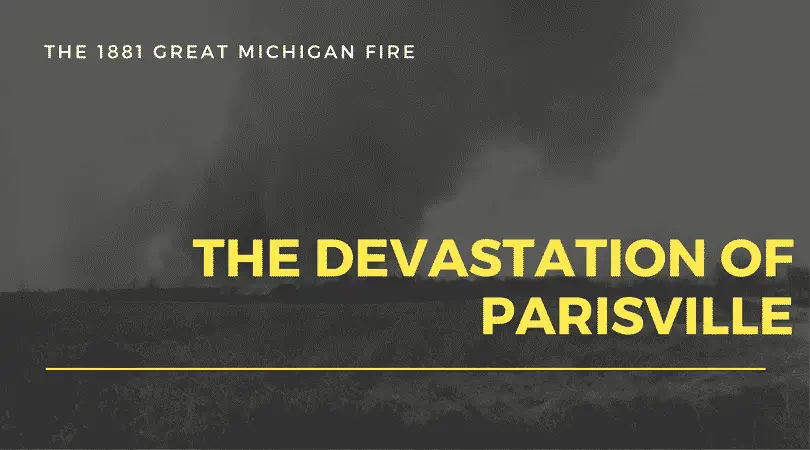

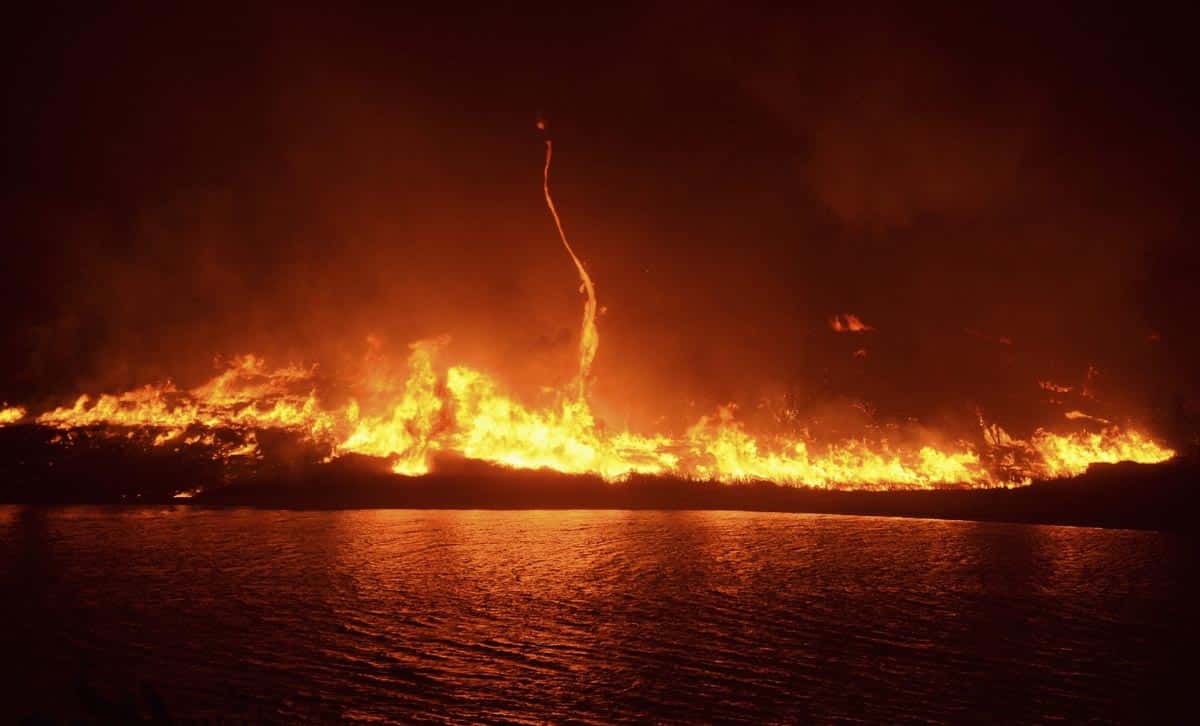

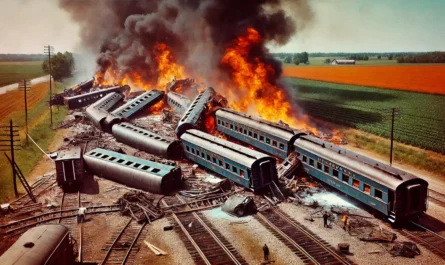
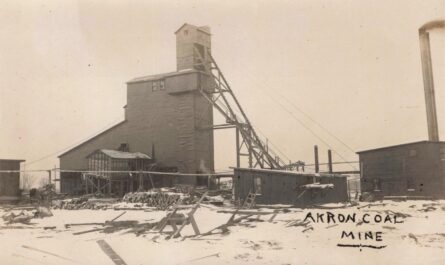
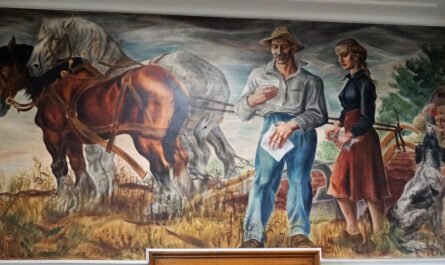
thank you very interesting. good to know